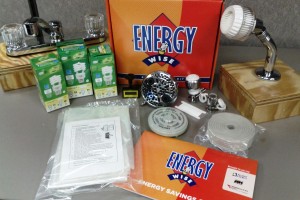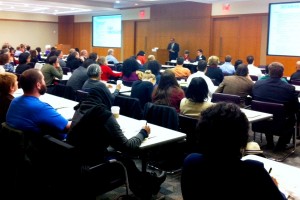As I made the journey back to Illinois to celebrate Christmas with my family, I reflected on what the past year has meant to me. At this time last year, I had no idea what I would do or even where I wanted to live after I graduated. I felt lost and a little nervous about whether the skills I learned in college would translate into a real job.
Since joining Energy Corps, I’ve written grant proposals, helped organize a regional sustainability conference, and organized meetings with mayors and city officials. While my college courses gave me an excellent grounding in political theory, I’ve learned so much more about environmental policy by attending community meetings and interacting with people involved in the energy field. Being an Energy Corps member has allowed me to better understand how cities actually work and how I can take an active role in educating the public and policy makers about local energy policies. Now in the second half of my Energy Corps term, I am setting my own green goals for the New Year: to switch all light bulbs in my apartment to CFL’s, to read one book on environmental and climate issues a month, and to go meatless 4 days out of the week.
 Just in time for Christmas, I worked with the Applied Sustainability Center to launch “The Green Corner Toolkit.” The toolkit is a collection of helpful worksheets, slides, and links aimed at reducing energy consumption in cities that might not otherwise have funds or personnel to focus on public energy education campaigns. It includes a list of useful energy-related links, including the home energy yardstick and home electricity purchasing worksheet from Energy Star; a green commitment pledge that motivates citizens to reduce consumption of energy, use less water, limit waste, and use locally sourced food; a worksheet that helps calculate annual electricity usage for households using monthly bills as a teaching tool; a worksheet to calculate home electricity usage by noting which appliances are most often plugged in; and a slideshow showing the benefits of switching to CFL light bulbs. These items can be posted on city websites or distributed as educational supplements.
Just in time for Christmas, I worked with the Applied Sustainability Center to launch “The Green Corner Toolkit.” The toolkit is a collection of helpful worksheets, slides, and links aimed at reducing energy consumption in cities that might not otherwise have funds or personnel to focus on public energy education campaigns. It includes a list of useful energy-related links, including the home energy yardstick and home electricity purchasing worksheet from Energy Star; a green commitment pledge that motivates citizens to reduce consumption of energy, use less water, limit waste, and use locally sourced food; a worksheet that helps calculate annual electricity usage for households using monthly bills as a teaching tool; a worksheet to calculate home electricity usage by noting which appliances are most often plugged in; and a slideshow showing the benefits of switching to CFL light bulbs. These items can be posted on city websites or distributed as educational supplements.
 As cities set out their priorities for the New Year, my hope is that they will use the toolkit to encourage their citizens to set their own energy goals for the year. For example, if every household were to switch from incandescent bulbs to CFL bulbs, they would save a significant amount of money as well as reduce carbon emissions. One CFL bulb can save about $40 in electricity over its lifetime and prevents more than 400 pounds of coal from being used in energy production.
As cities set out their priorities for the New Year, my hope is that they will use the toolkit to encourage their citizens to set their own energy goals for the year. For example, if every household were to switch from incandescent bulbs to CFL bulbs, they would save a significant amount of money as well as reduce carbon emissions. One CFL bulb can save about $40 in electricity over its lifetime and prevents more than 400 pounds of coal from being used in energy production.
I would like to see the “Green Corner Toolkit” evolve as cities add other educational websites and supplemental materials to it that encourage energy efficiency. My hope is that smaller cities around the state will use it as a starting point for future conservation efforts. Let’s use the new year to promote green habits, so that when we ring in 2015, we can look back on a year of progress!
 Elana Harrison is a recent graduate of Hendrix college with a major in International Relations and a Minor in German. She discovered a love for environmental policy while working with the Sierra Club’s Beyond Coal Campaign. She also worked as an intern with the Arkansas Public Policy Panel, where she tracked environmental, energy, and water-related policy during the 2013 session. Eland will be placed at the University of Arkansas’s Applied Sustainability Center, working on creating Energy Scorecards for municipalities around the state. She will work with eight cities in Arkansas to assist with strategic energy planning as well as energy outreach and education.
Elana Harrison is a recent graduate of Hendrix college with a major in International Relations and a Minor in German. She discovered a love for environmental policy while working with the Sierra Club’s Beyond Coal Campaign. She also worked as an intern with the Arkansas Public Policy Panel, where she tracked environmental, energy, and water-related policy during the 2013 session. Eland will be placed at the University of Arkansas’s Applied Sustainability Center, working on creating Energy Scorecards for municipalities around the state. She will work with eight cities in Arkansas to assist with strategic energy planning as well as energy outreach and education.








